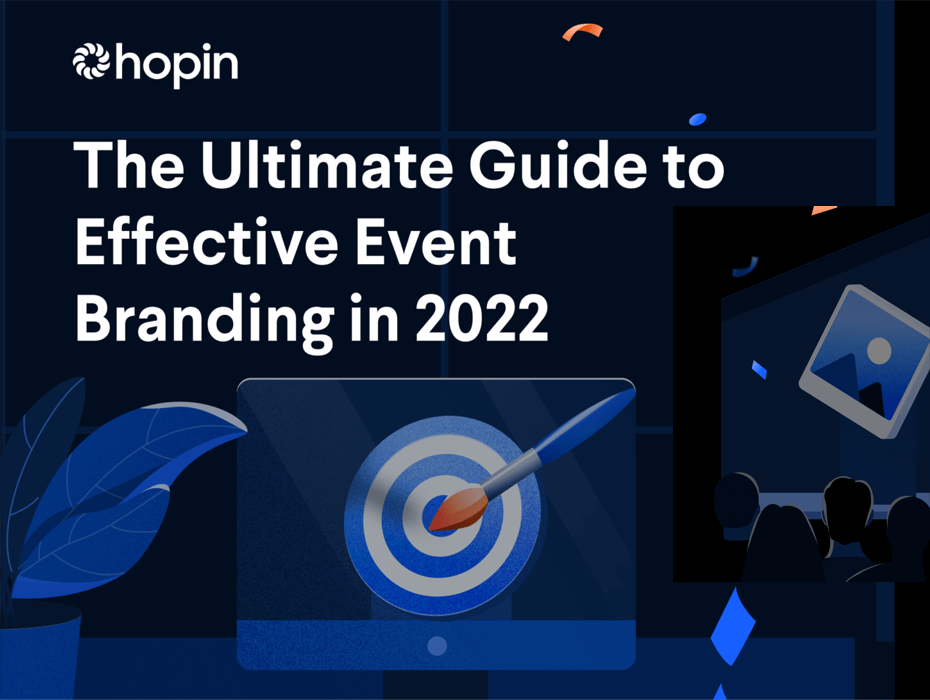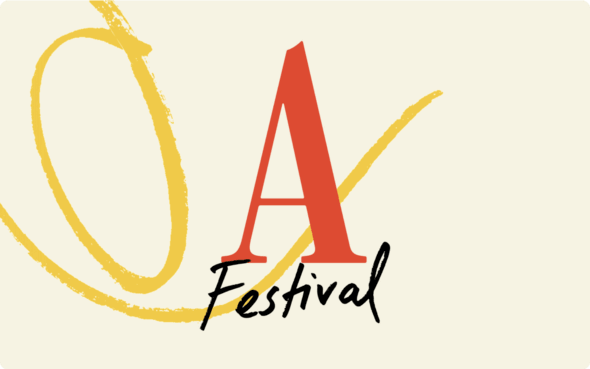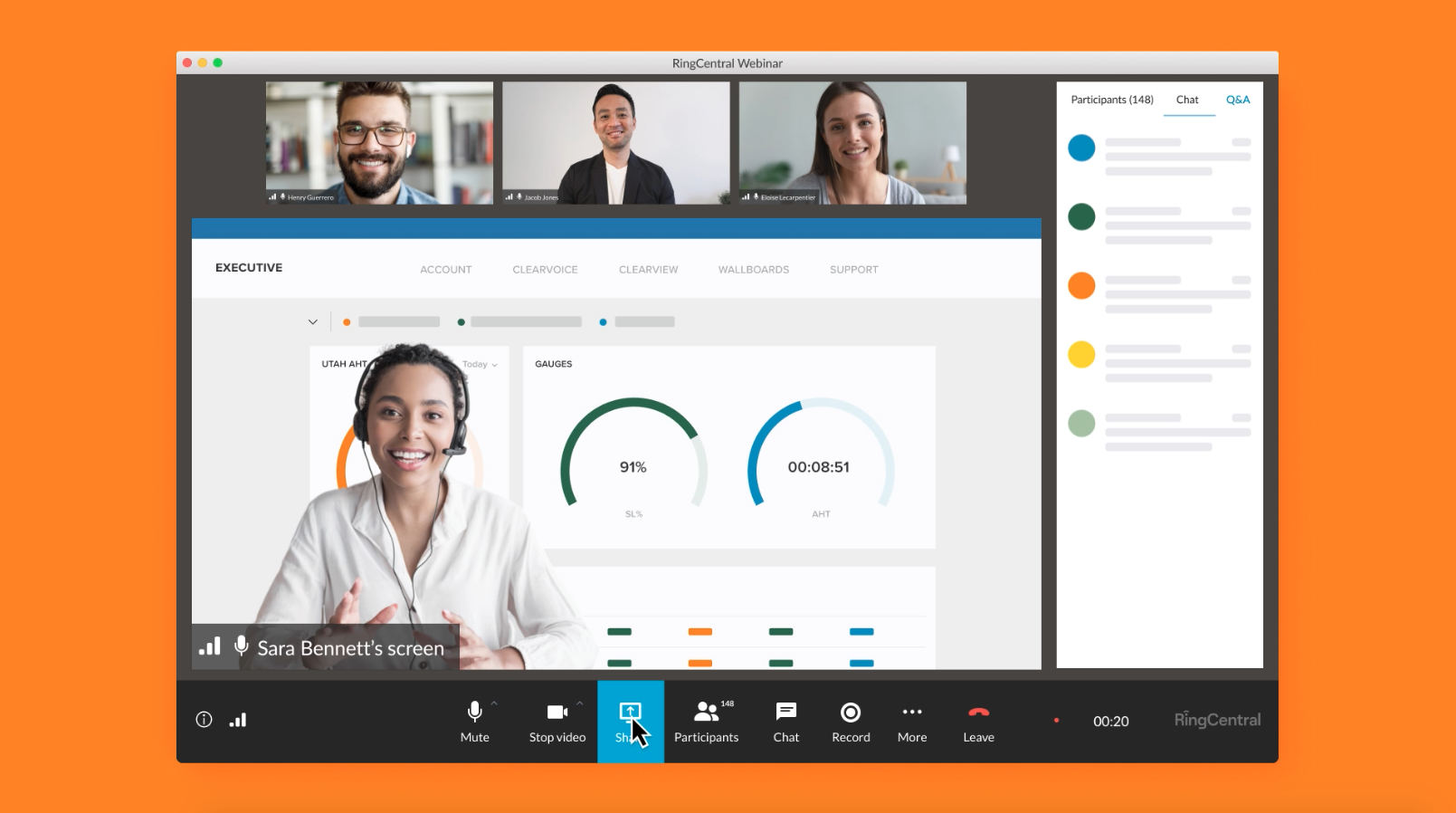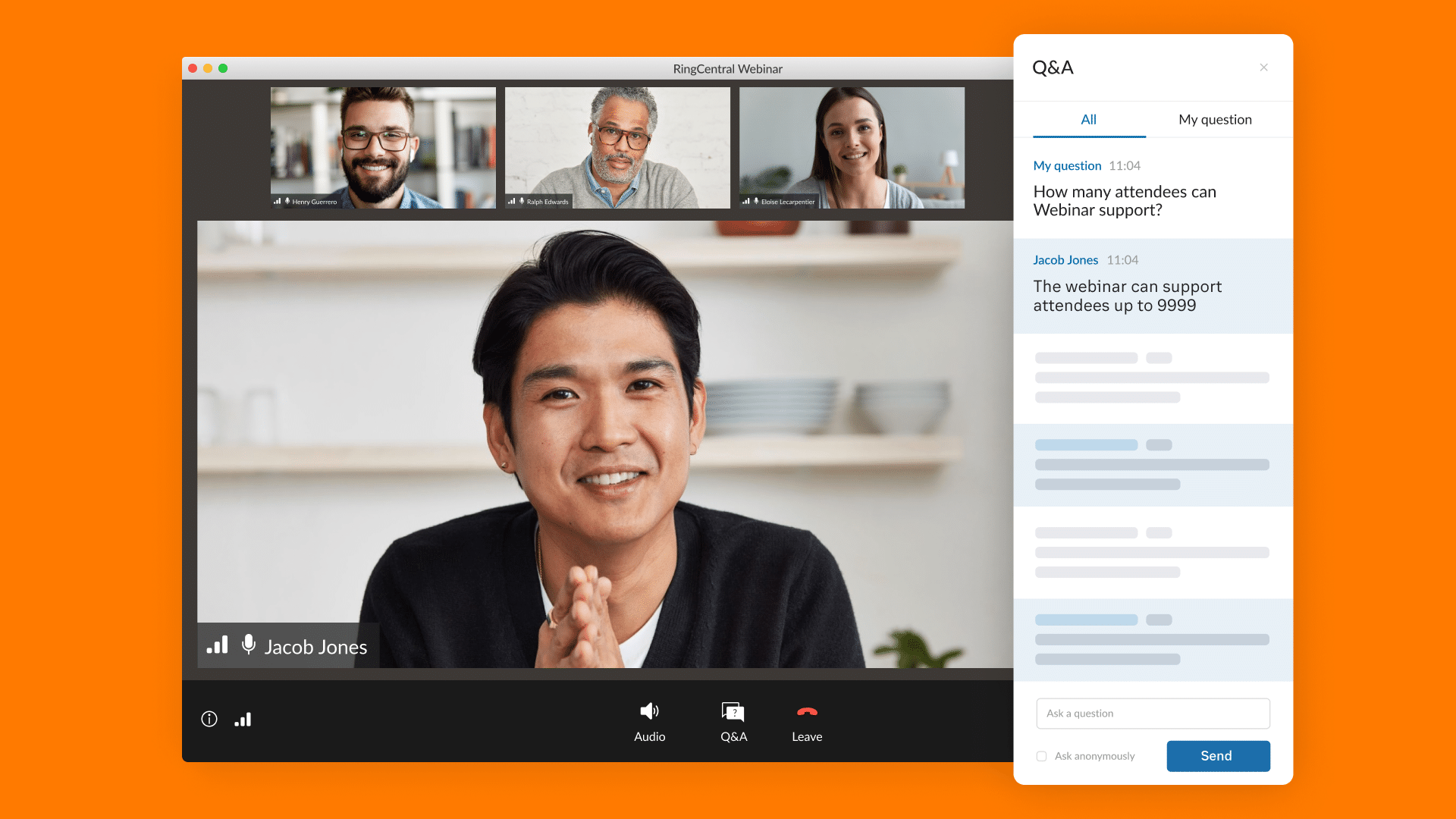“Just Do It.”
What comes to mind? A swoosh? A voice encouraging you to make your dreams a reality? A slow-motion video of an athlete in Nike gear? All of the above?
The name Nike immediately prompts thoughts of determination, high performance, and motivation –– all of which goes well beyond athletic clothing. That’s the power of branding.
Branding is a long-term investment that can deeply impact customer satisfaction, loyalty, and spend. It’s so influential that it can decrease price sensitivity and boost revenue.
Nike’s branding budget may be slightly higher than most, but there are still effective ways to ensure your event branding has a positive impact on attendees.
A strong event brand can support your event marketing efforts, excite your audience, and make it easier for you to achieve your goals –– all while impressing stakeholders along the way.
In short, event branding can help you:
- Stand out in the crowd
- Attract attendees
- Generate enthusiasm for your event
- Impress sponsors, partners, and other key stakeholders
- Drive registrations, ticket sales, attendance, and more
Follow the steps in this guide to build solid branding for your next event –– and to knock the socks off your attendees, sponsors, colleagues, and competitors.
In this guide:
Define your event’s value proposition
Deploy your branding and apply best practices
Explore how technology can support your event branding
First, know your why
Your event brand should be built around one question: Why does your event exist?
In his book, Start With Why, author Simon Sinek explains, “People don’t buy what you do, they buy why you do it.”
But it’s not just about why you think your event exists. Why should your audience care?
For example, Nike’s Run Club app facilitates in-person Run Club sessions in London. Why do these gatherings exist? Because Nike believes everyone is an athlete, and these events support the brand’s community members in their pursuit of movement.
Your audience is at the heart of your event and will be the driver of why you’re producing an event, and in turn, your event branding.
Define your event’s value proposition
Once you’ve articulated why your event exists, it’s time to fully outline the value the experience will deliver. What is your audience going to get out of attending your event? What are the benefits for them?
Use a simple framework to describe and position the value of your event.
Try this one:
For [insert the target audience], who [insert statement of the target audience’s need or opportunity], our [insert the product or service name] is or provides [insert a description of the product or service] that [insert the core benefits of the product or service].
For example, Nike’s Swim All value proposition reads:
For any woman in London, regardless of income, who wants to learn to swim, our six-week Swim All program provides a safe, inclusive opportunity to learn how to swim and feel comfortable in the water that empowers participants to build confidence, have fun, and get inspired to achieve their own greatness.
Try completing this type of framework for your event. Once you’ve defined the value of your event, you’ll be ready to explore how your event brand will deliver on this value proposition and start nailing down foundational branding elements.
Establish your event brand
You’ve done the legwork. Now you can begin to think about the tangible components that will help bring your event brand to life.
To start, you’ll want to establish the core pieces of your event branding puzzle: things like event name, logo, brand story, color palette, slogan, typography, voice, and imagery.
Let’s take a look at some of these components in more detail:
Event name
The name you use will be a key part of how your audience identifies your event and talks about the experience. It has to be something impactful that will resonate with audience members.
For example, Salesforce’s flagship event is called Dreamforce, which probably grabs you a little more than “Salesforce User and Customer Convention 2022,” right? Dreamforce has become a household name within the SaaS community and is now, in many ways, synonymous with event excellence.
Consider the thoughts and associations you’d like your event name to conjure long term and what type of name will stand out in the crowd. Don’t forget to make sure the name you’re going for hasn’t already been used or cornered by another organization.
Event logo
This is a visual shortcut to your event brand. Attendees will see it in your emails, on your event website, during your event, and beyond. They’ll associate it with what your event stands for, so creating this visual to represent your event is key.
The event logo for tech conference, Grace Hopper Celebration, is brightly colored and engaging, reflecting the event’s focus on diversity and intersectionality. The colors, representing women technologists across a spectrum of race, age, sexual orientation, and ability, form an arrow pointing upward, signaling positive change within the tech industry.
Slogan
In this case, a slogan is a short phrase that conveys the essence of your event brand via a core message.
Take TEDx’s slogan: “Ideas worth sharing.” This phrase quickly indicates to the audience that TEDx will expose them to interesting, thought-provoking ideas. Even if attendees don’t know much about the agenda, the slogan gives them an understanding of the value they’ll extract from a TEDx experience.
Visuals, fonts, and color palettes
These elements help communicate your brand identity. They create visual associations and evoke emotions around the experience you’re promising to deliver.
Your event look doesn’t have to match your organization’s everyday branding. Going in a new direction can draw attention and spark intrigue — just make sure you don’t step too far away from the core company motif.
For example, email platform Klaviyo hosted a holiday show that relied on the brand’s green-dominant color palette, but used a new, kitschy font to build on the holiday spirit.
Keep in mind that color can increase brand recognition by up to 80%. If you’re looking for some color palette inspiration, try free tools like Coolors, Colormind, or Adobe Color to help guide your visual brand elements.
Tone and voice
The tone and voice you use in all the copy associated with your event will give your audience a sense of the type of event they’ll be showing up to.
Take The Forbes Power Women Summit, which spotlights innovative women driving progress. Fittingly, their tone in event marketing materials and across their communication during the event is professional and inspiring.
You might want to define an adventurous, innovative, serious, or fun tone of voice for your event, depending on your audience, the type of experience you’re hosting, and what you’re trying to convey.
Deploy your branding and apply best practices
Once you have all the elements of your event brand locked and loaded, it’s time to start sending it all out into the world.
Make sure there’s consistency across your event communication and marketing materials so you don’t risk confusing your audience, and even worse, missing out on valuable registrations. Your event brand will influence how attendees perceive your event throughout the event lifecycle –– from the moment they see any promotional materials to the final post-event email.
Beyond digital deployment, an on-site or hybrid event has endless potential for physical event branding, from banners and beverages to tickets and toilet paper.
This isn’t just about marketing collateral –– it’s about a lasting impression, which means business outcomes (think: money) and your brand reputation are both on the line.
Let’s explore some of the areas to consider deploying your event brand.
Event website and registration area
Your event website is the core promotional asset for your event. It’s where all the elements of your event brand — your experience’s purpose, value proposition, name, logo, tagline, imagery, colors, and typography — come together to make your event stand out and help attract registrants.
Take the website for EventMinded, a mental health summit for event professionals hosted by RingCentral Events. The site displayed the event’s purpose and used dynamic shapes in blue tones to create a calming atmosphere.
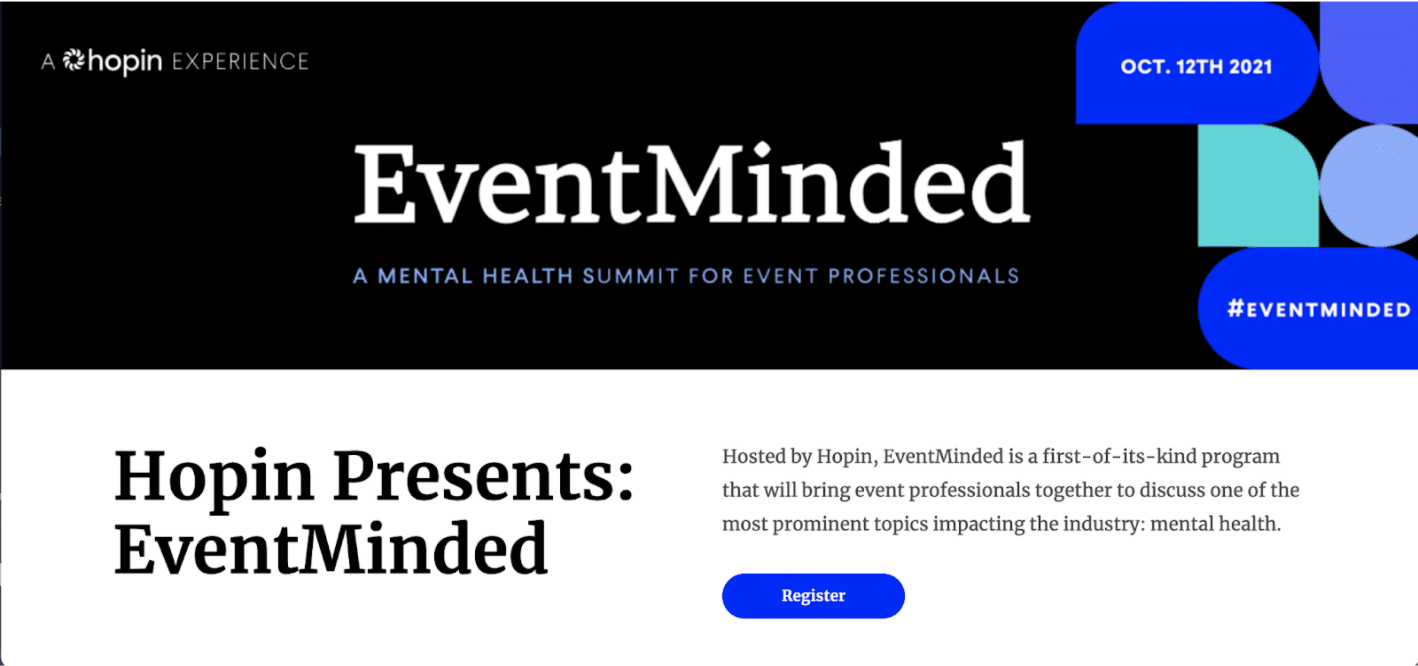
You don’t have to take a coding course to pull together a beautifully branded event website. Seek out event platforms that offer integrated event websites with pre-built themes and drag-and-drop customization capabilities.
You might also want to whitelabel your event URL. That means creating a custom URL that aligns with your event brand, so you can point people to yourcoolevent.com, versus yourcoolevent.websitename.com. There’s nothing wrong with the latter, but whitelabeling can help people remember your URL and make your website look more professional.
Virtual venue
If you’re hosting a hybrid or virtual event, your event brand will also take center stage in your virtual venue. Making full use of venue customization options to create an immersive brand experience.
Bring in the color palette, imagery, and banners, from the registration page to make the digital attendee experience come alive.
Email marketing
About 330 billion emails are sent and received each day. (A moment of appreciation for our overworked spam filters.) So, how do you make sure your event emails get noticed? Tap into your event branding, using the look, feel, and sound you’ve defined to hook potential attendees, help them understand the value of your event, and drive registrations.
Make this easier on yourself by looking for event technology that offers email and marketing tool integrations, so you can easily duplicate branding across all touchpoints and track data on marketing performance.
Social media moments
Event organizers recognize how powerful social media can be, before, during and after an event.
Before your event, if it makes sense for your audience, use relevant social media channels to build anticipation and drive registrations by sharing branded content. Include an event hashtag so attendees can find, share, and discuss related content.
During the event, you can use social media walls to capture and broadcast user-generated content from your event. These help attendees find one another, network, encourage content sharing, and produce a treasure trove of media to use in future event marketing.
Physical venue signage
Reinforce your event brand across on-site visuals like check-in signage, digital kiosks, venue maps, and stages.
Hopin’s hybrid Illuminate show featured branded check-in kiosks made possible by in-person event technology.
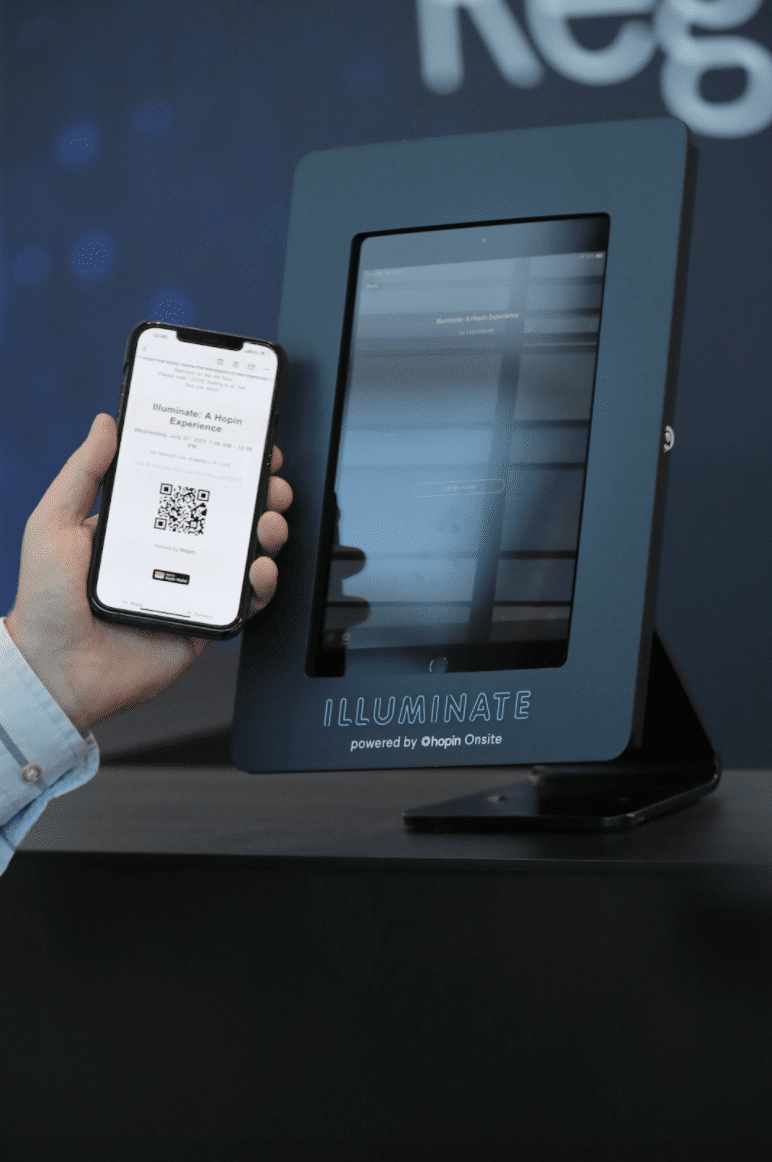
On-site decor and design
Choose the colors –– based on your established color palette –– and aesthetic for your event spaces (both in-person and virtual). This is one of the main elements that creates a common visual branding thread and reinforces your event theme.
The stage at Illuminate featured bright lights and late-night-TV-style chairs to emphasize a “live broadcast studio” experience.
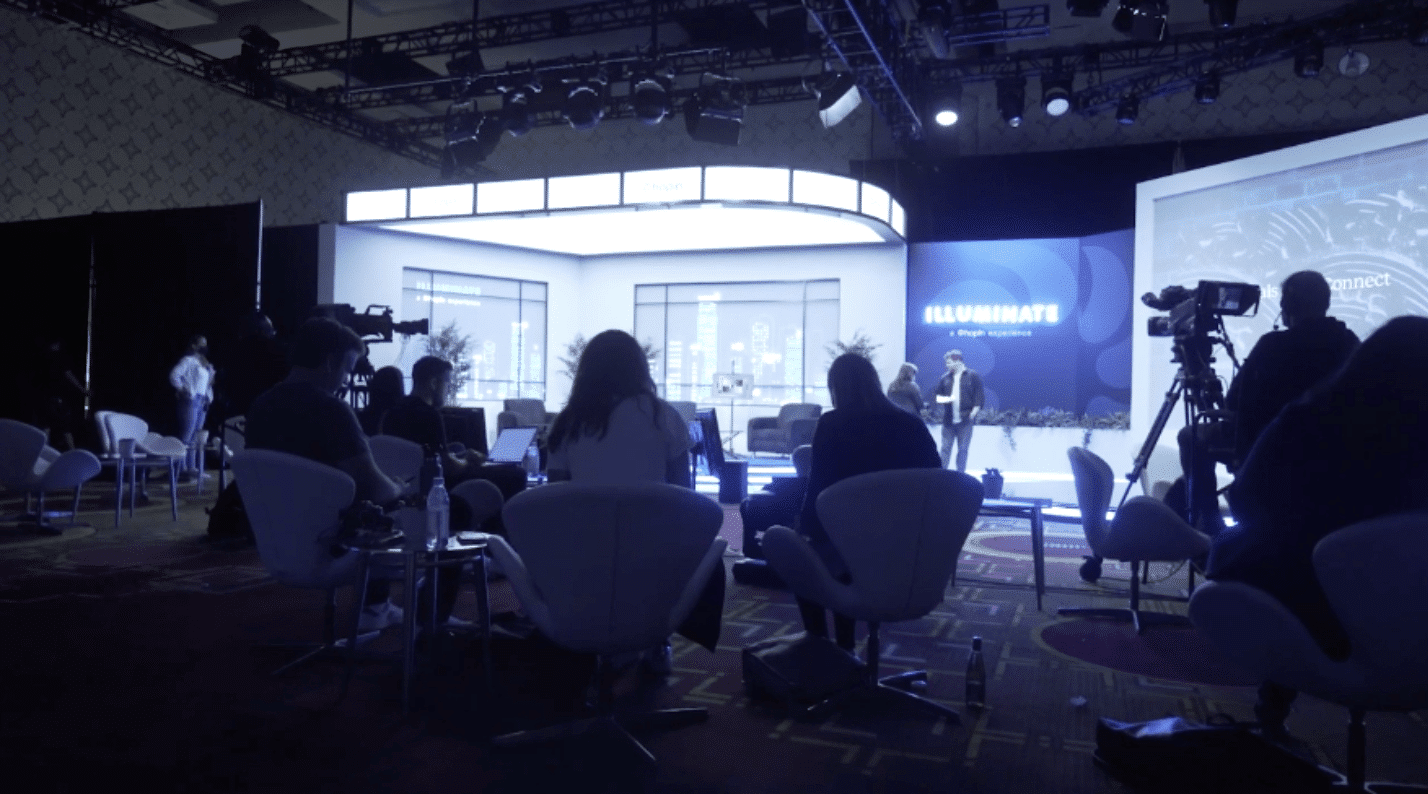
Food and beverage collateral
If you’re providing food and drink to attendees, take it a step further by infusing your event brand into the experience.
Consider branding food or beverage containers, developing clever names for what you’re serving, or providing things like free branded drink tickets for happy hours.
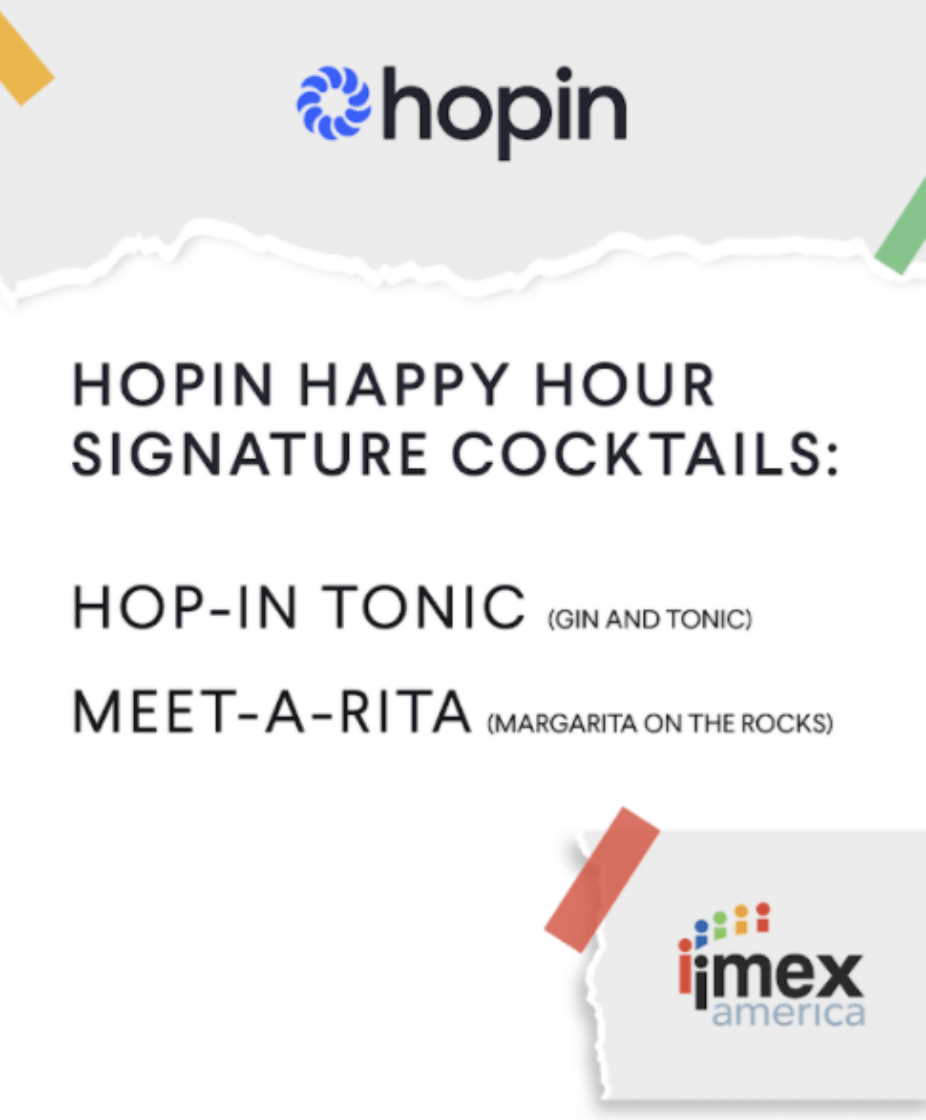
Swag
Your event brand can live forever with take-home goodies distributed to event attendees or contest winners. Consider incorporating opportunities for swag personalization and interactivity while holding true to your central brand.
For example, at IMEX, RingCentral Events offered customizable tote bags event attendees could then use to collect other conference swag they picked up along the way.
When thinking of swag to offer, ask yourself a few key questions:
- How does the branded swag connect to my organization and its values?
- What giveaways will attendees actually be able to use?
- What type of budget am I working with?
You could give out branded sunglasses at an on-site event in a warm place, or offer cover letter templates to attendees at a virtual career fair.
Want to learn more about hosting and marketing events? Read other Event Marketing Guides from RingCentral Events.
Explore how technology can support your event branding
Your event branding has to work hard for you. You need it to help you stand out, convince your target audience to register for the experience, and build memorable, positive associations for attendees.
These asks are made easier with an event platform that can streamline tasks, offer new branding opportunities, and use the power of technology to simplify brand implementation.
Want to learn more about how RingCentral Events can help you effectively brand in-person, hybrid, and virtual events? Contact our team of event experts to learn more today.
Originally published Sep 01, 2022, updated Nov 10, 2023
